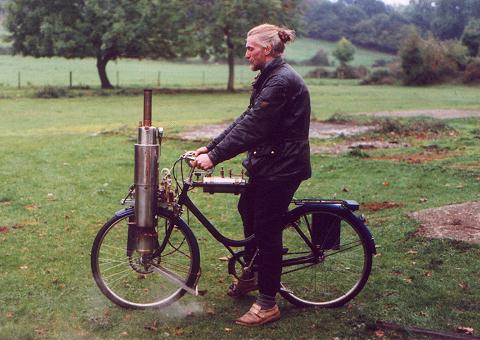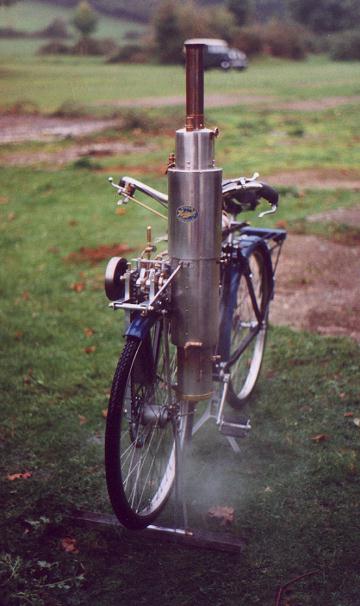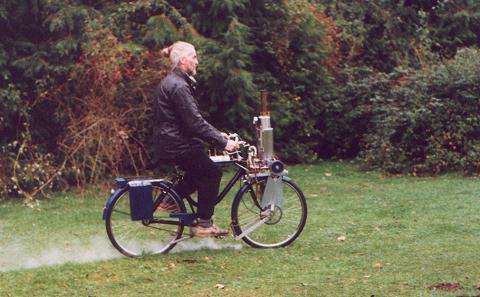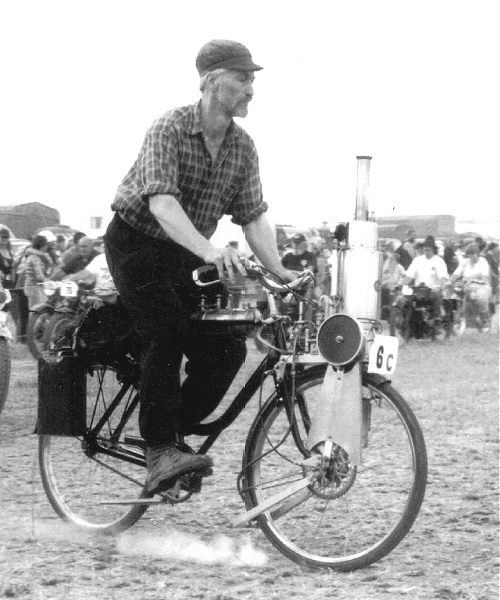 Go
to the Archive index
Go
to the Archive indexMany visitors to the Great Dorset Steam Fair (29th August - 2nd September 2001) were intrigued by the first appearance of my steam bicycle, after several years of eager anticipation.

The Ultimate VSX upgrade?
Geoff Hudspith astride the Hudspith Steam Bicycle
[Photo - Liz Tomkins]
It all began in 1972 when I first had the notion of making a steam bike, thus combining my interest in cycles and motor cycles with my fascination and love of steam. I reallsed that in order to be able to see the water level, the boiler and engine would have to go in front of the rider. I experimented using a pannier bag loaded with four house-bricks hung from the side of a rack, mounted over the front wheel of a bicycle. Finding that I could still ride OK, providing the load was rigidly fixed, I desigued a tall, narrow boiler, to keep the centre of gravity as close in to the wheel as possible. The next few years were spent obtaining the materials and means of making the boiler and it took me until 1989 to complete it in its initial form. It is a semi-flash type, having a lower section of concentric spiral water tubes fed by a central downcomer, surmounted by a fire-tube header which has 24 × 3/8" flues in a 4" diameter, copper cylindrical shell. The whole assembly is silver soldered throughout, and contains less than 1 litre of water in total. The boiler is fired from below by a pressure-fed paraffin burner of the Optimus type.
I thoroughly tested and gradually improved the boiler by driving engines belonging to my friend, Albert Crittell, whom I met at a steam rally in 1987. He gave me much encouragement, and some materials that I used in making my own engine, which was finished in its basic form by 1994.
The engine is a horizontai single-cylinder, double-acting one of my own design. The bore is 1 3/8" and the stroke is 1 1/4", giving about 1/4hp, depending on the pressure of the steam. I ran and exhibited the engine and boiler for several years as a stationary unit driving a 12V dynamo. During this period I made several improvements to the engine, eg: making a boiler feed pump driven by an eccentric on the crankshaft, and controlled by a by-pass valve to the right of the engine.
About 1989, I obtained a 1949 VéloSoleX premier type frame in a derelict and red rusted condition, and gradually set about restoring it, building new wheels, etc, to form the basis of the steam bike. I made twin top bars to support the paraffin tank and strengthen the swan-neck frame. The engine is pivoted from the fork crown to allow the front forks to flex in the normal way, and the chain tension is kept constant by struts down to the front wheel spindle. The transmission chain runs from the crankshaft sprocket to a chainwheel, filed out to fit a Sturmey-Archer 3-speed AW hub, giving a ratio of 5.33:1 which can be increased by 33% or lowered by 25%. Also, I have a neutral position between 2nd and 3rd gears, by using a friction lever to control the gear cable. This is useful for warming up the engine initially, and for stating and stopping.

After Ibsley Rally 2001:
Steam Bicycle is ticking over in neutral after a ride.
Front stand is resting in a piece of steel channel for safety on the
soft ground
[Photo - Liz Tomkins]
The weight of the boiler is largely counterbalanced by the weight of the flywbeel, transmission and water pump, etc, and the water tank on the rear right hand side when underway. It is only ever a problem when lifting the machine up or down the stairs to my first floor council flat, single handed, when the front end tries to flop over to the left all the time.
To start, after raising 100psi steam pressure (which takes 15 - 20 minutes from cold), I pedal off with the engine ticking over in neutral, then slip her into gear and open the regulator. It is possible to change gear by easing off the steam to allow the machine to over-run the engine speed, then of course opening up in the new gear. To stop, I can either just close the regulator, and coast to a halt, or ease it back and put her in neutral, leaving the engine ticking over. She will climb most main road hills in top gear, maybe with a little LPA if the pressure drops too much.

Setting off for a ride at Ibsley 2001
[Photo - Liz Tomkins]
At present (this winter) I am making an improved burner of my own design that will, I hope, give about half as much heat again as the Optimus does and also be more reliable. The Optimus, in fairness, was never meant to burn in an enclosed firebox, and thus it tends to puff out at times, which is a nuisance. The new burner should improve the performance by enabling the machine to run at full pressuie all the time, which in steam terms is more efficient.
Present performance is about 8mph sustained speed, 6 - 8mpg of water and about 60 - 70mpg of paraffin (at a guess). Such a machine is never truly finished, and most times I run it, I think of an improvement to make for next time. After all, it has only taken me 30 years so far!
First published, February 2002
I will attempt to describe the improvements that I have made since the machine first ran in October 2000. Insufficient steam was the first main problem to be overcome. The Optimus paraffin burner originally fitted did not like burning in an enclosed firebox and rapidly carbonised, causing a reduction in performance. Also, the vaporisation was not reliable when the burner was turned down low.
I made a replacement burner similar to the Stanley steam car type, having a flame plate 4in in diameter instead of 5/32in thick stainless steel and with 400 holes, 1.3mm diam, to fill the entire area of the water-tube firebox with flames. The first vaporiser was a circular tube of 3/16in OD stainless steel about nine inches long and 1/4in above the flameplate when in situ. This worked well on paraffin but needed to be decarbonised after about every 3 hours of use, so I then tried a straight across pipe of thicker walled stainless, 3/4in above the flameplate. This proved insufficiently hot to vaporise paraffin, so I began using about 4/5 unleaded petrol and 1/5 paraffin mixture as fuel. Fine, but sometimes if I turned the burner down whilst the engine idled in neutral, the vaporiser tube would cool down too much, and suddenly there would be liquid fuel dripping down and causing a little fire on the ground - not good for public relations.
So, in the spring of 2005, I have made a double tube version, with the lower tube 3/16in above the flameplate, a kind of two-stage vaporiser, so that even when the burner is turned down low, the lower tube is right in the flames. This has overcome the fire problem, but once again I must decarbonise the lower tube about every 3-4 hours. I hope to overcome this eventually by experimentally shielding it to various degrees, to keep its temperature below the fuel's cracking point.
Perhaps ultimately an atomising burner would work better than a vaporising one, but I have yet to discover a way of atomising the fuel without the use of electricity, which I am reluctant to involve for reasons of weight and over-complication. A new improved superheater now allows much greater efficiency by reducing losses due to cylinder condensation, though I found that its spiral copper coil needed to be wound with mnemonic alloy strip to protect it from melting at the hottest point.

The machine is now reliable enough to take part in European steam rallies, which I have done since the first Demark trip in 2003. The most recent addition to it I have made is a steam whistle, which several people have been urging me to do for some years.
A problem still to be overcome is the intermittent whistling made by the burners. This is produced by the gas flow through the burner causing the flames to oscillate, so producing a note of about 1kHz. As it comes and goes whilst running, it is very difficult to isolate precisely what is the cause. Many of the steam cars had the same problem, I am told. I have recently tried lagging the burner casing to stabilise its temperature, but to no effect, although more steam is available as a result.
The mechanical lubricator has also been the subject of examination, to reduce the previous excessive oil consumption and I have recently made a sight-glass on the oil-feed pipe to the steam chest. This allows me to observe the small but constant flow whilst riding. A centrifugal separator on the exhaust downpipe now extracts about 2/3 of the oil, so preventing oil puddles on the ground if I am stationary with the engine running for a few minutes, as often happens when people wish to talk to me at steam rallies. I have fitted a larger bore exhaust downpipe to compensate for the slight back pressure caused by the oil separator.
I have increased pressure in the boiler to 125psi, resulting in more available power in reserve for hill climbing. I have reduced the steam cut-off from a previous 80% to 60% resulting in greater efficiency by using steam more expansively. Following a gasket leak on the rear cylinder cover whilst riding in the Cugnot celebration at Viod-Vacon (near Nancy) in France last year, I have replaced all the paper gaskets in the engine with copper ones. These should be 100% reliable. I have replaced the original silver-steel piston-rod and valve rod with a stainless one, as originals had become a little rust pitted. No significant wear was found anywhere in the engine, but I honed out the gun metal cylinder about .002in to remove some slight scoring, and made an oversize cast-iron piston, as the original piston was also a little rust pitted. The engine has had more than 11 years use; 6 years driving a dynamo and 5 years on the actual steam bicycle. The rusting was caused by the inevitable water droplets that remain in the engine after use.
The machine is reliable enough to take part in European events and at the time of writing (July '05) I have had four trips abroad with it and am leaving for Germany again soon. It seems that foreign rally organisers welcome the publicity that the steam bicycle brings them.
First published, December 2005